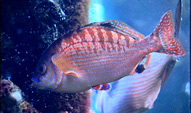Part 1.
The oceans remain a relatively unexplored frontier, as only 5 percent of the ocean floor has been investigated. Put into context, more than 1,500 people have climbed Mount Everest, more than 300 have journeyed into space, 12 have walked on the moon, but only 2 people have descended and returned in a single dive to the deepest part of the ocean.” —2009 Joint Oceans Commission Initiative
According to the results of two major scientific reports, the just released Joint Ocean Commission Initiative: Changing Oceans, Changing World (PDF); and the 2003 report by the Pew Oceans Commission entitled America’s Living Oceans (PDF), the health of the world’s oceans are in crisis from overfishing, pollution, climate change and destruction of native habitat.
Both reports issue a call to arms; a need to comprehensively address the fundamental effects of human activity on the oceans, marine coastal areas, and estuaries. In addition to being a primary source of food for feeding growing populations of people (6 billion in the world today), the oceans moderate our climate; perform the essential role of absorbing excess carbon (half of all fossil carbon [dioxide] released into the atmosphere since the beginning of the industrial revolution has been absorbed in the ocean); through the creation of rain, the main source of our fresh water; and the largest generator of oxygen on the planet. Simply put, the fate of all life on Earth is thoroughly intertwined with the fate of the oceans.
Alison Barratt, from the Monterey Bay Aquarium’s Seafood Watch program discusses the health of the oceans in relation to native fish populations, and the decline of their ecosystems. In the last 50 years, industrial fishing practices have severely lowered fish populations, altering the balance of species diversity within ecosystems. Fishing practices have also led to destruction of native habitats, and increased collateral damage to unintended fish caught by accident (bycatch). Nitrogen pollution from agricultural runoff, sewage, and automobile and factory emissions, have created more than 150 different “dead zones,” areas of water—under a one-mile square radius to as large as 45,000 square miles in size containing such depleted levels of oxygen—within each, no fish can survive.
Some highlights taken from the Pew Oceans Commission report on the health status of the oceans:
- As of 2001, the government could only assure that 22% of fish stocks under federal management (211 of 959 stocks) were being fished sustainably.
- By 1989, populations of New England cod, haddock, and yellowtail flounder had reached historic lows. In US waters, Atlantic halibut are commercially extinct—too rare to justify a directed fishing effort. Populations of some rockfish species on the West Coast have dropped to less than 10 percent of their past levels.
- A 2003 National Academy of Sciences study estimates that the oil running off our streets and driveways, and ultimately flowing into the oceans is equal to the Exxon Valdez oil spill-10.9 million gallons- every 8 months (NRC, 2002).
- The amount of nitrogen released into coastal waters along the Atlantic seabord and the Gulf of Mexico frtom anthropogenic (human) sources has increased about fivefold since the Pre-industrial era, and may increase another 30% by 2030 if current practices continue (Howarth et al., 2000).
- Over the past decade, nearly one million non-native Atlantic salmon have escaped from fish farms and established themselves in streams in the Pacific Northwest.
- Coastal marshes, which trap floodwaters, filter out pollutants, and serve as “nurseries” for wildlife, are disappearing at a rate of 20,000 acres per year. Louisiana alone has lost half a million acres of wetlands since the 1950’s.
- Bottom-dwelling invertebrates can take up to five years or more to recover from one pass of a (fishing trawler) dredge.
- Climate change will modify the flow of energy and cycling of materials within ecosystems—in some cases, altering their ability to provide the ecosystem services we depend upon.
- Just as the 20th century brought us into knowledgeable contact with outer space, the 21st will almost certainly connect us more intimately to our oceans. …As much as we love our oceans—our ignorance has been destroying them.
See related videos: Seafood Watch Discover how to find what fish are sustainably harvested, and how you can do your part to help improve the health of the oceans. Sardines: Sustainable Food to Feed the World Dr. Geoff Shester, the Senior Science Manager, Monterey Bay Aquarium’s Sustainable Seafood Initiative describes a sustainably managed fish, high in protein and healthy nutrients, abundant, inexpensive to produce, that could feed a large number of people, affordably. So what’s the problem?
Most of the videos featured on Cooking Up a Story were produced, filmed, and edited by Rebecca Gerendasy. Fred Gerendasy contributed as a writer to many of the posts and occasionally as the interviewer. Visit Rebecca Gerendasy Clay – Art and Fred Gerendasy Photography to see their current work.

